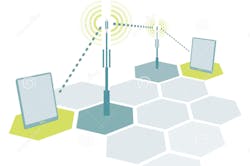For IoT applications, the limited space and exact positioning of the microcontroller unit (MCU) and sensors tend to limit the antenna’s geometric flexibility. Although they’re highly efficient and wideband, differential antennas typically require more space and precise design geometries—features that aren’t available on most crammed IoT PCBs. Many IoT antennas are therefore single-ended, which allows them to take advantage of the isolated ends and crammed footprints of IoT-module PCBs.
Most IoT RF integrated circuits (RFICs) have differential transceiver (TRX) ports to the antenna. Using a single-ended antenna architecture therefore requires a balun. A balun also is needed when unbalanced transmission lines, such as coaxial cables, are used to feed the antenna. However, baluns add cost and require valuable PCB real estate near the MCU. Single-ended antenna options also tend to perform less efficiently than differential ones. Given the compressed antenna-typology geometry options, though, the IoT module designer may not have much choice.
Antenna design is an exercise in tradeoffs. Many antenna performance parameters often compete with physical and electrical characteristics. In the case of IoT modules, however, antenna design concerns are compounded. The proximity to other electronics and the size/cost/power constraints limit performance. Factors like antenna placement, groundplanes, antenna mismatch, line-of-sight disruption, and inter-device interference are all application-specific design issues. The antenna typology selected also will directly impact gain characteristics, frequency, bandwidth, radiation pattern, and radiation efficiency. For a low-power, small-size, and high-reliability design to be achieved, adequate consideration must be placed on the antenna as the key connecting technology for IoT modules.
About the Author
Jean-Jacques DeLisle
Jean-Jacques graduated from the Rochester Institute of Technology, where he completed his Master of Science in Electrical Engineering. In his studies, Jean-Jacques focused on Control Systems Design, Mixed-Signal IC Design, and RF Design. His research focus was in smart-sensor platform design for RF connector applications for the telecommunications industry. During his research, Jean-Jacques developed a passion for the field of RF/microwaves and expanded his knowledge by doing R&D for the telecommunications industry.
